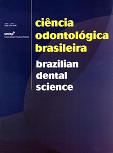Silicones para próteses faciais: efeito da desinfecção química sobre dimensão e superfície - parte II
DOI:
https://doi.org/10.14295/bds.2004.v7i1.476Abstract
O objetivo desta pesquisa foi avaliar a influência da desinfecção química sobre a estabilidade dimensional e a manutenção de detalhes de um silicone para uso facial. Os corpos-de-prova foram confeccionados com uma atriz, de acordo com a especificação no 19 da A. D. A. e a revisão ISO 4823:1984 para materiais de moldagem elastoméricos não-aquosos, sendo divididos em 3 grupos: controle (incolor), pigmentado com maquiagem e com óxido de ferro, analisados sem a ação da desinfecção e sob a ação da desinfecção química. Os corpos-de-prova foram observados em microscópio comparador, para a verificação da alteração dimensional e em lupa estereoscópica, para a análise da reprodução de detalhes. Essas leituras foram realizadas imediatamente, trinta e sessenta dias após a polimerização dos corpos-de-prova, com e sem desinfecção química. Os dados foram submetidos à análise estatística, pelo teste de Tukey, em nível de 5% de probabilidade. A desinfecção química somente alterou dimensionalmente o grupo Silastic com maquiagem, porém esta contração foi inferior à recomendada pela A. D.A. Pôde-se concluir que a clorexidina não promoveu alterações significativas ao material. A fidelidade e manutenção da reprodução de detalhes obtida para todos os corpos-de-prova não foi influenciada pela ação da desinfecção química.
Downloads
Downloads
Published
How to Cite
Issue
Section
License
Brazilian Dental Science uses the Creative Commons (CC-BY 4.0) license, thus preserving the integrity of articles in an open access environment. The journal allows the author to retain publishing rights without restrictions.
=================




























